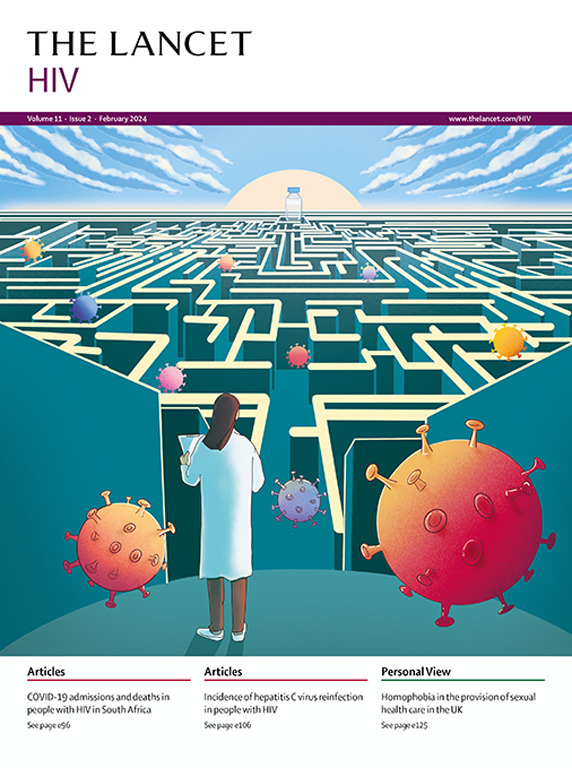准消灭班氏杆菌对坦桑尼亚西南部HIV发病率的影响:一项为期12年的前瞻性队列研究
IF 13
1区 医学
Q1 IMMUNOLOGY
引用次数: 0
摘要
背景在坦桑尼亚西南部引入抗蠕虫治疗计划之前,我们的研究小组描述了感染班克罗非虫的成年人中艾滋病发病率增加了 2-3 倍。2007 年至 2011 年间,班克罗非虫感染者的艾滋病发病率为每 100 人年 1-91 例,而未感染者的发病率为每 100 人年 0-80 例。方法通过线虫感染艾滋病毒的风险(RHINO)研究是一项前瞻性队列研究,该研究使用了 2007-11 年新干预措施影响评估与监测(EMINI)研究期间收集的一个村庄参与者的数据,以及 2019 年收集的 EMINI 参与者的新数据。研究参与者在 2007 年至 2011 年期间每年接受一次艾滋病毒和循环丝虫抗原(班克罗夫绦虫感染的指标)检测,2019 年接受一次检测。从 2009 年到 2015 年,每年都会通过政府计划向所有村民发放驱虫药,随后进行传播评估调查。我们分析了 2007 年加入 EMINI 时 HIV 检测结果呈阴性的 14-65 岁人群的数据。我们进行了多层次混合效应泊松回归,以描述和比较年龄调整后的发病率和性别调整后的发病率。结果在 2019 年重新筛查的 1299 名前研究参与者中,有 1139 人在 2011 年最后一次监测期结束时艾滋病毒检测呈阴性,并被纳入本次分析。552(48-5%)名参与者为女性,587(51-5%)名参与者为男性,年龄中位数为 26.4 岁(IQR 19-8-37-8)。在纳入的 1139 名参与者中,848 人(74-5%)从未检测出班克罗夫氏菌感染呈阳性,272 人(23-9%)曾检测出阳性但在 2019 年未感染班克罗夫氏菌(治愈者),15 人(1-3%)在 2007-11 年和 2019 年均检测出班克罗夫氏菌感染呈阳性,4 人(0-4%)在 2019 年新感染了班克罗夫氏菌。2011 年至 2019 年期间,在 848 名未感染班克罗夫特梭菌的参与者中,艾滋病毒发病率为每 100 人年 0-68 例(95% CI 0-50-0-93)(5724 人年中新增 39 例艾滋病毒感染者);在 272 名治愈者中,艾滋病毒发病率为每 100 人年 0-73 例(0-45-1-17)(2344 人年中新增 17 例艾滋病毒感染者;调整年龄和性别后的发病率比为 1-14,95% CI 0-64-2-04;P=0-65)。在2007-11年和2019年,班克罗夫氏梭菌感染检测呈阳性的15人中,HIV发病率为每100人年1-5例(0-39-6-04)(131人年中新增2例HIV感染;调整后的IRR为3-43,95% CI为0-8-15;p=0-10)。在班克罗夫特梭菌检测从未呈阳性的人群中未观察到这种效应,这支持了班克罗夫特梭菌在艾滋病毒感染中的作用。本文章由计算机程序翻译,如有差异,请以英文原文为准。
Impact of quasi-elimination of Wuchereria bancrofti on HIV incidence in southwest Tanzania: a 12-year prospective cohort study.
BACKGROUND
Before introduction of anthelmintic treatment programmes in southwest Tanzania, our group described a 2·3-fold increase in HIV incidence among adults infected with the helminth Wuchereria bancrofti. Between 2007 and 2011, HIV incidence was 1·91 cases per 100 person-years in people with a W bancrofti infection and 0·80 cases per 100 person-years in those without the infection. We aimed to examine the impact of a reduction in W bancrofti infection as a result of mass drug administration on HIV incidence in southwest Tanzania.
METHODS
The Risk of HIV Infections through Nematode Organism (RHINO) study is a prospective cohort study that used data from participants in one village collected during the Evaluation and Monitoring of the Impact of New Interventions (EMINI) study in 2007-11 and new data from EMINI participants collected in 2019. Study participants were tested for HIV and circulating filarial antigen (an indicator of W bancrofti infection), once a year from 2007 to 2011 and once in 2019. From 2009 to 2015, anthelmintics were annually distributed to all villagers through government programmes, followed by transmission assessment surveys. We analysed data from individuals aged 14-65 years with negative HIV test results at enrolment in EMINI in 2007. We did multilevel mixed-effects Poisson regression to describe and compare age-adjusted and sex-adjusted incidence rates.
FINDINGS
Of the 1299 previous study participants rescreened in 2019, 1139 had been HIV-negative at the end of the last surveillance period in 2011 and were included in this analysis. 552 (48·5%) participants were female and 587 (51·5%) were male, and the median age was 26.4 years (IQR 19·8-37·8). Of the 1139 participants included, 848 (74·5%) never tested positive for W bancrofti infection, 272 (23·9%) previously tested positive but did not have a W bancrofti infection in 2019 (cured individuals), 15 (1·3%) tested positive for W bancrofti infection both in 2007-11 and 2019, and four (0·4%) had a new W bancrofti infection in 2019. Between 2011 and 2019, HIV incidence rate was 0·68 cases (95% CI 0·50-0·93) per 100 person-years in the 848 participants with no W bancrofti infection (39 new HIV infections during 5724 person-years) and 0·73 cases (0·45-1·17) per 100 person-years in the 272 cured individuals (17 new HIV cases during 2344 person-years; incidence rate ratio (IRR) after adjusting for age and sex 1·14, 95% CI 0·64-2·04; p=0·65). HIV incidence rate was 1·5 cases (0·39-6·04) per 100 person-years in the 15 individuals who tested positive for W bancrofti infection both in 2007-11 and in 2019 (two new HIV infection in 131 person-years; adjusted IRR 3·43, 95% CI 0·8-15; p=0·10).
INTERPRETATION
In the group of participants cured of W bancrofti infection, the HIV incidence significantly decreased in 2011-19 compared with 2007-11, the period when they tested positive for W bancrofti infection. This effect was not observed in the group of individuals who never had a positive W bancrofti test, supporting the role of W bancrofti in HIV infection.
FUNDING
The EU as part of EuropAid and Deutsche Forschungsgemeinschaft.
TRANSLATION
For the Swahili translation of the abstract see Supplementary Materials section.
求助全文
通过发布文献求助,成功后即可免费获取论文全文。
去求助
来源期刊

Lancet Hiv
IMMUNOLOGYINFECTIOUS DISEASES&-INFECTIOUS DISEASES
CiteScore
19.90
自引率
4.30%
发文量
368
期刊介绍:
The Lancet HIV is an internationally trusted source of clinical, public health, and global health knowledge with an Impact Factor of 16.1. It is dedicated to publishing original research, evidence-based reviews, and insightful features that advocate for change in or illuminates HIV clinical practice. The journal aims to provide a holistic view of the pandemic, covering clinical, epidemiological, and operational disciplines. It publishes content on innovative treatments and the biological research behind them, novel methods of service delivery, and new approaches to confronting HIV/AIDS worldwide. The Lancet HIV publishes various types of content including articles, reviews, comments, correspondences, and viewpoints. It also publishes series that aim to shape and drive positive change in clinical practice and health policy in areas of need in HIV. The journal is indexed by several abstracting and indexing services, including Crossref, Embase, Essential Science Indicators, MEDLINE, PubMed, SCIE and Scopus.
 求助内容:
求助内容: 应助结果提醒方式:
应助结果提醒方式:


